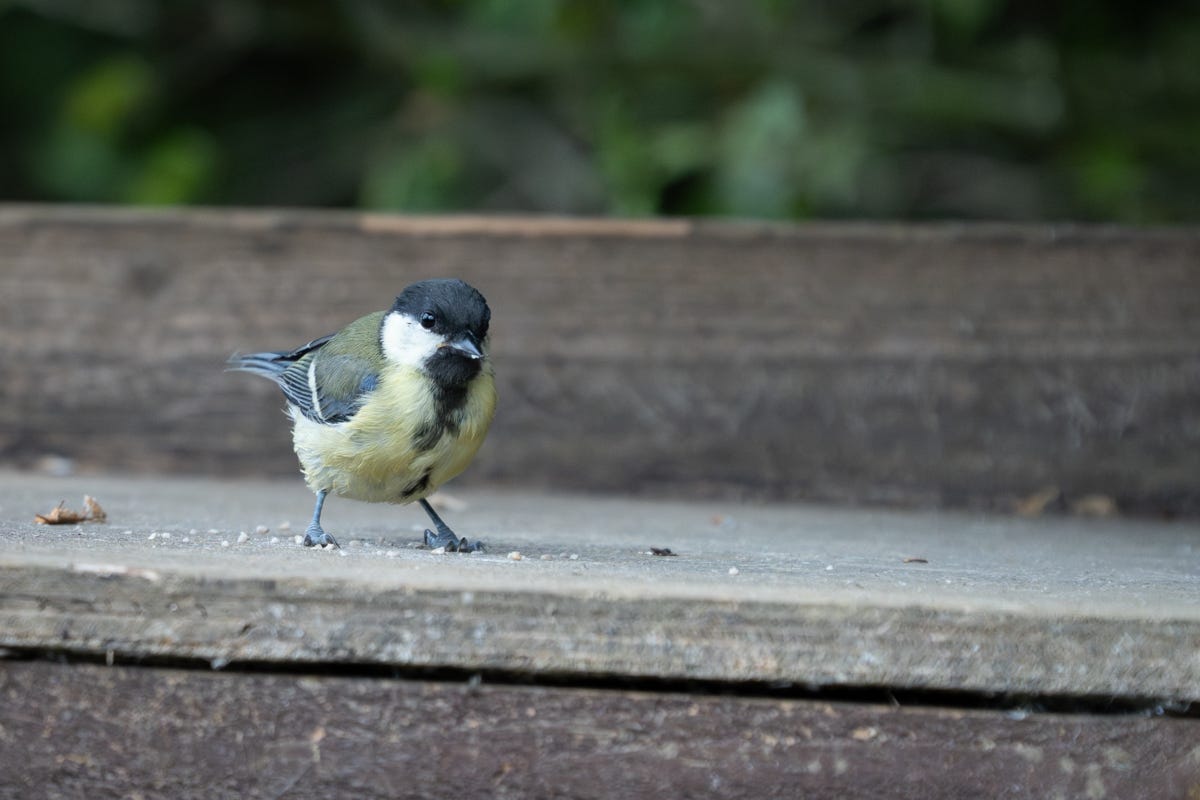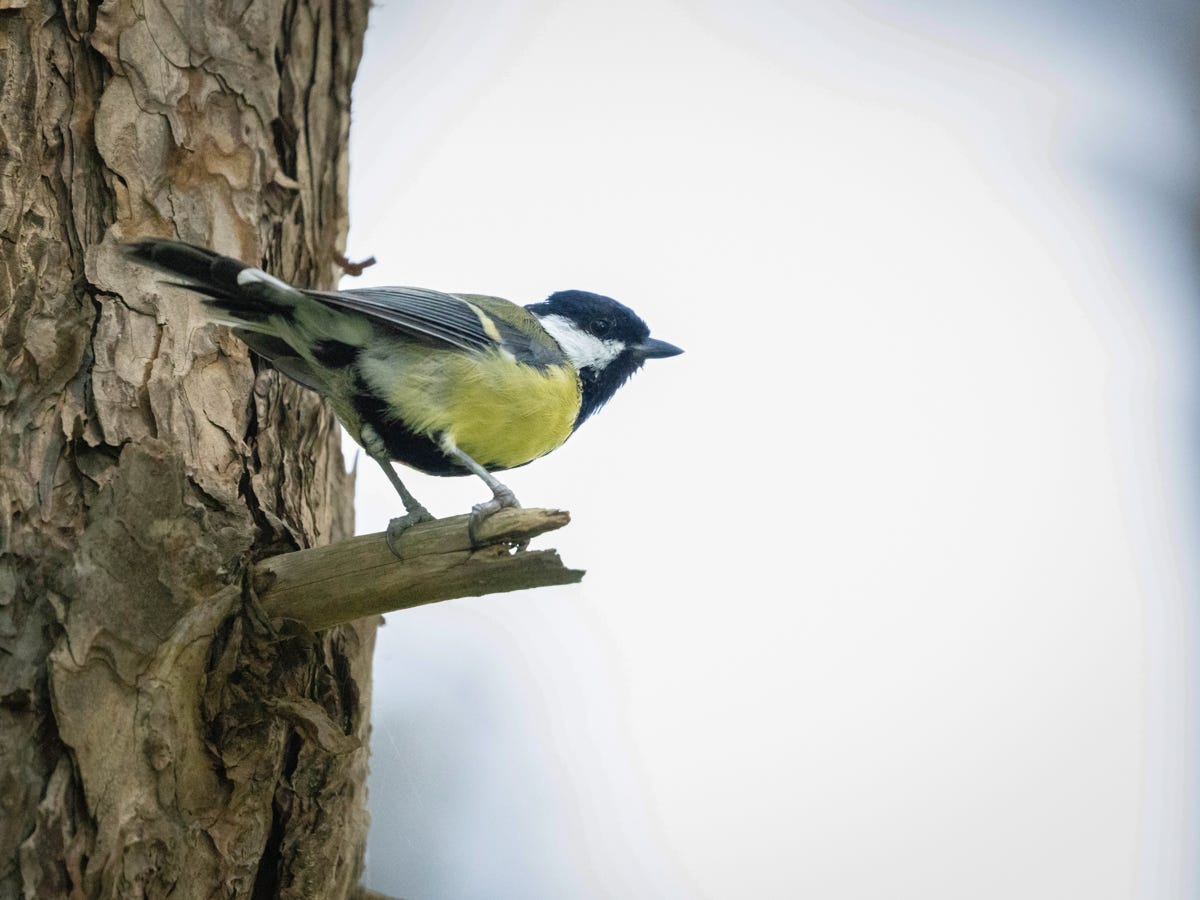Meet the Great Tit
The deceptive yellow bird at the feeder.
This week, our birdwatcher is once again watching the feeders. Among the tittering Goldfinches is a black and yellow tit – but there’s no growling alarm call this time. A similar feeding pattern to last week’s Blue Tit, but less aggressive with other birds. And, from the bush nearby, a familiar and pleasant call: “Tea-cher, tea-cher, tea-cher”.
It’s got to be the (seemingly) more polite cousin of our Blue Tit – a Great Tit!
ID features
With a black cap, chin stripe and breast streak, the Great Tit has a neat little uniform. The thickness of the black collar and stripe tells you if it’s male or female, with males having more black plumage. However, there’s overlap between the thickest black pattern on females and the thinnest on males – like many things, it’s an indication rather than a sure way to tell.
The yellow breast, olive green back and dark legs are shared with the Blue Tit, but this bird averages 18g to the Blue Tit’s 11g, so it’s much bigger. They do also have an alarm call and other sounds that anyone with a bird feeder will likely recognise – the alarm sounds to me like “seep, DWEEE-EEEP”, and the others are pleasant chirps and tweets.
But their ‘tea-cher’ courtship call is their signature sound. It is a sure sign that Spring is in full flow.
Feeding behaviour
Much like their blue cousins, Great Tits largely feed on insects when they’re available and supplement with seeds and fat from feeders as required. I say it’s more polite than Blue Tits, because the smaller bird often chases Great Tits away. But Great Tits themselves can be quite aggressive to other species!

A bit of a horror show…
The Great Tit is the most widespread species in the Parus genus of birds, and does not migrate. If you’ve spotted one nearby, you’ll probably continue to be blessed with their presence.
I was initially concerned there wasn’t much ‘special’ about Great Tits, and this might be a bit of a dull read. As ever, mother nature has proven me wrong – check out this fact, courtesy of Wikipedia:
It is predominantly insectivorous in the summer, but will consume a wider range of food items in the winter months, including small hibernating bats.
Wait… what?

So I dig deeper, and it turns out these otherwise ordinary little birds are actually ridden with bloodlust. That rather neat little beak of theirs is capable of cracking acorns and hazelnuts, so it’s got the means. And according to many and varied sources, here are some of the things it likes to eat at the expense of others:
Winter caches of food stored by other birds.
A Goldcrest (a very small bird)
Redpolls (a small finch)
Yellowhammers (actually quite a large finch)
Carrion – that is, dead farm animals in particular
“the fat and other tissues of hanged people”
They have also been found happily nesting on the mauled remains of Spotted Flycatchers who dared to choose a nest site that the Great Tit fancied. Bettina Boxall gathered all this knowledge in a letter to Scientific American, titled Great tits: still murderous, rapacious, flesh-rending predators, which I have to say I would have been perfectly happy to have never read.
Where to spot a Great Tit
These beautiful little birds are found across the whole of the UK, except the highest highlands and the northernmost islands. They are originally woodland birds, but happily visit gardens in towns and cities too.
Easily confused with
Great Tits are bigger than Blue Tits and have black heads and chin/chest stripes. They do share many features with Blue Tits, such as the yellow chest, white cheeks and olive green back. Fortunately, these lookalikes often hang about in mixed flocks, making it easy to contrast the two species against each other.
Coal Tits also don’t have any blue or yellow on them, and feature a white stripe down the back of the head that Blue Tits lack. They are very small and also tend to dart from cover to the feeder and back again, which can make it hard to get a clear sighting of. They may also be found in mixed flocks, but often are found on their own or in pairs in deep woodland.

Bonus Great Tit facts
The words in the Latin name, Parus major, mean simply ‘tit’ and ‘larger’.
Regional nicknames include: big ox-eye, black-capped lolly, black-headed bob, joe ben/joe bent, sawfinch, saw sharpener, sharp saw.
Great Tits have been seen using pine needles to extract insects from underneath bark.
Great Tits adapt their song in urban areas with low frequency noise pollution, including higher frequency notes – presumably to make themselves heard over the din.
Welsh mythology associates Great Tits with healing.
Estonian folklore credits Great Tits with bringing good luck and happiness (unless you’re a sleeping bat, presumably).
Great Tits are highly social birds, forming strong bonds with their partner and other members of the flocks that form in autumn.
Great Tits are one of the most-studied of our British birds, with tonnes of ecological research benefitting from their propensity to use manmade nest boxes and tolerate human presence.
Have you seen a Great Tit this week? Did you know that they’re predatory?





Some rather shocking facts about this bird that is so common even people who aren't interested in birds know it, but I still love them.
I had no idea they were such homicidal maniacs!